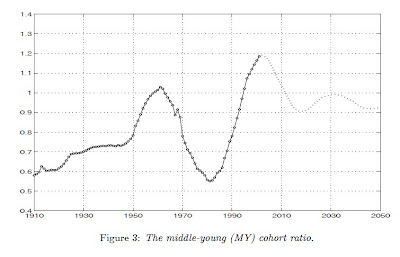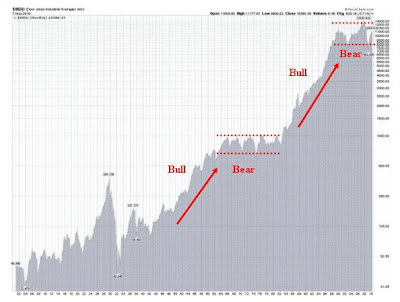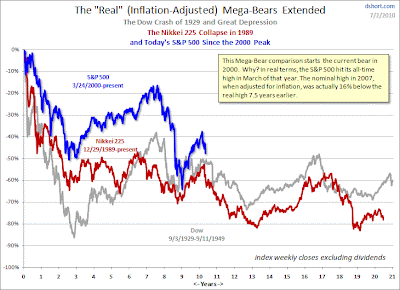USA Today recently asked How will Baby Boomers' retirement affect stocks?
I may have an answer from academia. Further to my post about anxious and volatile markets, John Geanakoplos, co-author of the paper entitled Leverage cycles and the anxious economy, also wrote another intriguing paper called Demography and the Long-Run Predictability of the Stock Market, with Michael Magill of the University of Southern California and Martine Quinzii of the University of California at Davis.
In this study, Geanakoplos et al related demography to long-term stock returns. They found that P/E ratios were correlated to the ratio of middle-aged people to young adults, otherwise known as the MY ratio. When MY rises, the market P/E will tend to rise and when it falls, P/Es tend to fall.
If the conclusions of the study are correct, then we should see a continued fall in P/E ratios with a long-term bottom in stock prices forming about 2018, or eight years from now.

Back to the '70s
Recall that the previous anxious markets paper that I cited indicated that current macroeconomic conditions called for volatile markets in the aftermath of the economic crisis. This latest paper suggests that we are gripped by a secular bear market until 2018. Putting it all together, the current environment is reminiscent of the 1970s, which was gripped by inflationary fears, slow growth, volatile markets and flattish equity returns.
The chart below of the Dow Jones Industrials Average shows that, since the Second World War, the market has been gripped by two episodes of secular bull markets to be followed by secular bears. The secular bulls were characterized by a substantial advance lasting over a decade while secular bears were marked by sideways markets lasting over a decade.

These studies are also consistent with the big bear charts atdshort.com, where Short shows the progress of the stock markets following the Great Depression and Japan’s Lost Decades.

Flat markets mean flat returns
Investors who accept such a scenario need to change their approach to investment policy. The buy-and-hold approach, long espoused by investment advisors during bull markets, will result in subpar returns in range-bound periods. Flat markets mean flat returns.
During secular bear markets characterized by flat returns, investors need to use dynamic asset allocation techniques such as the Inflation-Deflation Timer model to capture the swings of a flat market.
Cam Hui
http://humblestudentofthemarkets.blogspot.com/
I may have an answer from academia. Further to my post about anxious and volatile markets, John Geanakoplos, co-author of the paper entitled Leverage cycles and the anxious economy, also wrote another intriguing paper called Demography and the Long-Run Predictability of the Stock Market, with Michael Magill of the University of Southern California and Martine Quinzii of the University of California at Davis.
In this study, Geanakoplos et al related demography to long-term stock returns. They found that P/E ratios were correlated to the ratio of middle-aged people to young adults, otherwise known as the MY ratio. When MY rises, the market P/E will tend to rise and when it falls, P/Es tend to fall.
If the conclusions of the study are correct, then we should see a continued fall in P/E ratios with a long-term bottom in stock prices forming about 2018, or eight years from now.

Back to the '70s
Recall that the previous anxious markets paper that I cited indicated that current macroeconomic conditions called for volatile markets in the aftermath of the economic crisis. This latest paper suggests that we are gripped by a secular bear market until 2018. Putting it all together, the current environment is reminiscent of the 1970s, which was gripped by inflationary fears, slow growth, volatile markets and flattish equity returns.
The chart below of the Dow Jones Industrials Average shows that, since the Second World War, the market has been gripped by two episodes of secular bull markets to be followed by secular bears. The secular bulls were characterized by a substantial advance lasting over a decade while secular bears were marked by sideways markets lasting over a decade.
These studies are also consistent with the big bear charts atdshort.com, where Short shows the progress of the stock markets following the Great Depression and Japan’s Lost Decades.

Flat markets mean flat returns
Investors who accept such a scenario need to change their approach to investment policy. The buy-and-hold approach, long espoused by investment advisors during bull markets, will result in subpar returns in range-bound periods. Flat markets mean flat returns.
During secular bear markets characterized by flat returns, investors need to use dynamic asset allocation techniques such as the Inflation-Deflation Timer model to capture the swings of a flat market.
Cam Hui
http://humblestudentofthemarkets.blogspot.com/